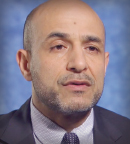According to the results of the phase III randomized Prostate Cancer Study 5 (PCS5), a noninferior trial, 5 weeks of radiation therapy may be equivalent to 8 weeks for men with high-risk prostate cancer on androgen-deprivation therapy. These findings were presented at the 2022 American Society for Radiation Oncology (ASTRO) Annual Meeting.1
“This is the first phase III study of moderate hypofractionated radiotherapy in high-risk patients with prostate cancer treated with contemporary radiation fields and long-term androgen-deprivation therapy [and no surgery]. The survival curves were merely identical. Hypofractionated radiotherapy is as effective as conventional radiotherapy, with similar, acceptable toxicity, and we think this should be the new standard of care for high-risk prostate cancer patients planned for external-beam radiation therapy and long-term androgen-deprivation therapy,” stated lead author Tamim M. Niazi, MDCM, Associate Professor of Oncology at McGill University and a radiation oncologist at Jewish General Hospital, Montreal.

Tamim M. Niazi, MDCM
Previously, other randomized trials have confirmed the safety and efficacy of moderately shortened (ie, hypofractionated) radiotherapy for low-, intermediate-, or mixed-risk prostate cancer. PCS5 is the first phase III study to look specifically and exclusively at men with high-risk disease.
The advantages of a shorter course of radiation compared with the conventional 8 weeks are many, as safety and tolerability are similar and clinically accpetable. “Hypofractionated treatment of prostate cancer decreases the financial toxicity to patients, and it is completed in 25 days instead of the usual 38 to 40 days. That’s 3 weeks of not having to come to the clinic—transportation, parking costs, and just the time it takes away from a person’s day-to-day life,” Dr. Niazi explained.
Methodology, Outcomes, and Safety Data
From February 2012 to March 2015, PCS5 enrolled 329 men at 12 different sites in Canada. They were randomly assigned 1:1 to receive moderately hypofractionated radiotherapy (68 Gy in 25 daily sessions) vs conventional radiotherapy (76 Gy in 38 daily sessions). To enroll, patients had to have high-risk disease, defined by a Gleason score of 8 to 10; stage T3a or higher disease; or a prostate-specific antigen (PSA) level ≥ 20 ng/mL. All patients received radiation to the pelvic lymph nodes and long-term androgen-deprivation therapy (28 months) before, during, and after radiation therapy, with a median duration of 24 months.
Evaluable patients included 159 in the hypofractionated radiotherapy arm and 160 in the standard radiotherapy arm. At 7 years, overall survival was almost identical for both groups of patients: 81.7% vs 82%, respectively. Prostate-specific mortality was also almost identical: 5.1% vs 3.6%, respectively. Biochemical failure–free survival was 87.4% vs 85.1%, respectively. Distant metastatic recurrence–free survival was identical: about 92% in both study arms. Disease-free survival (including biochemical recurrence or distant recurrence) was similar: 86.5% with hypofractionated radiotherapy vs 83.4% with conventional radiotherapy.
When data were analyzed at 3, 5, and 7 years of follow-up, there was no difference in survival, prostate cancer–free survival, biochemical failure, and rates of distant metastases. These results suggest the equivalency of these outcomes in both arms of the study at these time points.
“Acute toxicity was pretty similar between the two arms,” Dr. Niazi said. “There were no significant differences in grade 3 or higher acute and delayed genitourinary and gastrointestinal toxicities at 2 years, and no new toxicities were reported after that. No grade 4 toxicities were reported in either study arm.
“Grade 1 and 2 gastrointestinal toxicities peaked earlier, and there was a higher incidence in the hypofractionated arm,” he noted. After 6 months from randomization, grade 2 toxicities were seen in 55% of those given hypofractionated radiotherapy vs 49% of those given conventional radiotherapy. Grade 2 gastrointestinal toxicities were reported in 15% and 12%, respectively. Grade 2 genitourinary toxicity was higher in the standard arm (3 vs 11), but the numbers were too small to make meaningful comparisons.
“Moderate hypofractionated radiotherapy should be a new standard of care for high-risk patients with prostate cancer considered for primary external-beam radiotherapy and long-term androgen-deprivation therapy,” Dr. Niazi concluded.
Additional Commentary
At a press conference where this abstract was featured, ASTRO President-Elect Jeff M. Michalski, MD, MBA, FASTRO, of Washington University School of Medicine, St. Louis, was enthusiastic about these results.
“We have known for several years now that shortened hypofractionated radiotherapy is beneficial for low- and intermediate-risk patients with prostate cancer. It is associated with similar outcomes to conventional radiotherapy, and patients tolerated shortened treatment very well. However, most of the clinical trials of hypofractionated radiotherapy did not include high-risk patients, probably because the volume of disease is larger and might include pelvic lymph nodes. In addition, there was concern that shortening the course might lead to unacceptable toxicity,” Dr. Michalski explained.

Jeff M. Michalski, MD, MBA, FASTRO
“Therefore, adoption of shorter courses of radiation has been very slow, and it is not yet considered a standard of care for high-risk prostate cancer. That’s why this trial is so important. This trial has shown that reducing the number of treatments that included lymph node irradiation was tolerable, with no increased toxicity.”
“There are several advantages, including economic benefits and access with 8 weeks of daily visits. Now we can deliver the radiotherapy in 5 weeks. Maybe we can even use shorter schedules, and ongoing studies are looking at this hypothesis,” Dr. Michalski continued.
“I do think this study will lead to seeing shorter courses of radiation available for patients with high-risk prostate cancer. Thank you for this practice-changing trial,” he stated.
DISCLOSURE: Dr. Niazi has received research funding from AbbVie, Astellas, Bayer, Janssen, Amgen, Sanofi, AstraZeneca, TerSera, and Tolmar, and has received honoraria from AbbVie, Astellas, Bayer, Janssen, Amgen, Sanofi, AstraZeneca, TerSera, Knight Therapeutics, Paladin, Watson, Merck, Ferring, and Tolmar. Dr. Michalski reported no conflicts of interest.
REFERENCE
1. Niazi TM, Nabid A, Malagon T, et al: Conventional vs. hypofractionated radiotherapy for high-risk prostate cancer. 2022 ASTRO Annual Meeting. Abstract 4. Presented October 23, 2022.

